Standards:
USB 2.0 Hubs
USB 3.0 (3.2 Gen 1) Hubs
USB 3.2 Gen 2 Hubs
USB Type-C Hubs
The USB-4COMi-SI-M is a USB to Quad RS-422 485 Optical isolated serial adapter and is designed for commercial and industrial communication applications where Optical Isolation is a must have. The USB-4COMi-SI-M Serial Adapter instantly adds four RS-422, or RS-485 serial communication ports to your system while offering optical isolation and surge protection.
The USB-4COMi-SI-M is a USB to Quad RS-422 485 Optical isolated serial adapter and is designed for commercial and industrial communication applications where Optical Isolation is a must have. Serial RS-422 or RS-485 port expansion is made simple with the USB-4COMi-SI-M by connecting to a host USB port on your computer or USB hub for Plug-and-Play installation and automatic serial device detection.
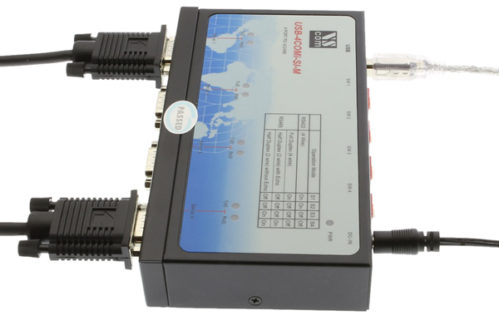
The USB to Quad RS-422 485 does not require additional IRQ or DMA configuration so it does not use memory as a resource on the system, therefore there are no conflicts. The adapter is self-powered, and one power supply adapter of 6V/2.1 Amp is included.
The adapter is designed with a four external 4-pin dip switches (pictured below) to set RS-422 or RS-485 mode conveniently, without the need to open the metal chassis. Each port can be independently set to RS-422 or to RS-485, depending on your requirement in application.
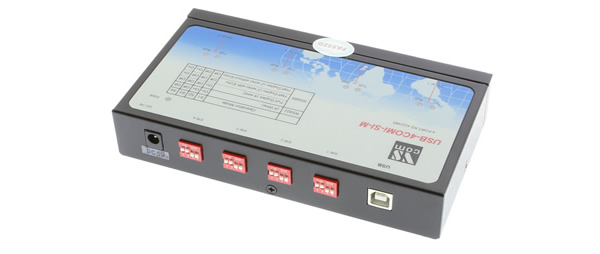
The USB-4COMi-SI-M USB to Quad RS-422 adapter has a built-in surge protector to withstand electrostatic discharges and power surges up to 25KV ESD. The USB to RS-422/485 Adapter provides instant connectivity to RS-422 or RS-485 communication devices for POS, factory automation equipment, multi-drop data collection devices, bar code readers, time clocks, scales, data entry terminals, PC to PC long distance communications, ATMs and serial data communication in harsh environments. The adapter’s USB to Industrial I/O provides industrial solution requiring single node or multi-drop communications over short and long distance.
Additional Features:
OS Support:
*Surface Mounting screws not included.
| Power |
| ||||||||||
|---|---|---|---|---|---|---|---|---|---|---|---|
| Compliance |
| ||||||||||
| Physical Characteristics |
| ||||||||||
| Serial Attributes |
| ||||||||||
| Software |
| ||||||||||
| Environmental |
| ||||||||||
| Hardware |
| ||||||||||
| Performance & Safety |
| ||||||||||
| Other Data |
|
| USB Bus | |
| Compliance | USB 1.0/1.1 compliant, USB 2.0 compatible |
| Speed | 12 Mbps, full-speed USB |
| FIFO | 128 byte transmit FIFO 384 receive FIFO |
| Serial Interface | |
| Port Type | RS-422/RS-485 |
| Number of Ports | 4 |
| Connectors | DB9 male |
| Serial Line Protection | |
| ESD Protection | 25KV |
| Optical isolation | 2000V DC |
| Serial Port Speed | |
| Baudrate | 300 bps to 921.6k bps |
| Serial Communication Parameters | |
| Data Bits | 5, 6, 7, 8 |
| Stop Bits | 1, 1.5, 2 |
| Parity | None, Even, Odd, Space, Mark |
| Flow Control | RTS/CTS, XON/XOFF |
| Serial Signals | |
| RS-422 | TxD-(A), TxD+(B), RxD+(B), RxD-(A), GND, RTS-(A), RTS+(B), CTS+(B), CTS-(A) |
| RS-485-4 wire | TxD-(A), TxD+(B), RxD+(B), RxD-(A), GND |
| RS-485-2 wire | Data-(A), Data+(B), GND |
| Driver Support | |
| OS | Windows 7, Vista, 2003, XP (WHQL certified) and 2000 Linux Kernel 2.4 and up built-in support |
| Power Supply | |
| Input | Self-powered Power adapter of 5VDC, 2A |
| Mechanical | |
| Chassis | SECC metal chassis with DIN rail bracket |
| Environmental | |
| Operating Temperature | 0 to 55 °C (32 to 131 °F) |
| Operating Humidity | 5 to 95% RH |
| Storage Temperature | -20 to 75 °C (-4 to 167 °F) |
| Safety Approvals | EN55022 Class B, EN55024, EN61000-3-2, EN61000-3 IEC 61000-4-2, IEC 61000-4-3, IEC 61000-4-4, IEC 61000-4-5, IEC 61000-4-6, IEC 61000-4-8, IEC 61000-4-11. CISPR PUB. 22 and FCC Part 15 Class B. |
|
RS-422 & RS-485 DB9 Male Connector Pin-outs |
||||||||||||||||||||||||||||||||||||||||
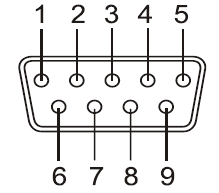 |
||||||||||||||||||||||||||||||||||||||||
| RS-422 DB9 Male | ||||||||||||||||||||||||||||||||||||||||
| RS-422 Signal Pin-outs of DB-9 Male | ||||||||||||||||||||||||||||||||||||||||
|
||||||||||||||||||||||||||||||||||||||||
| RS-485 DB9 Male | ||||||||||||||||||||||||||||||||||||||||
|
RS-485 4-Wire (Full duplex) Signal Pin-outs of DB-9 Male Connector |
||||||||||||||||||||||||||||||||||||||||
|
||||||||||||||||||||||||||||||||||||||||
|
RS-485 2-Wire (Half duplex) Signal Pin-outs of DB-9 Male Connector |
||||||||||||||||||||||||||||||||||||||||
|
||||||||||||||||||||||||||||||||||||||||
|
RS-422 Signal Wiring |
||||||||||||||||||||||||||||||||||||||||
|
Point-to-Point 4 Wire Full Duplex |
||||||||||||||||||||||||||||||||||||||||
|
USB-4COMi-SI-M RS-422 Device |
||||||||||||||||||||||||||||||||||||||||
|
RS-422 with Handshaking |
||||||||||||||||||||||||||||||||||||||||
|
USB-4COMi-SI-M RS-422 Device |
||||||||||||||||||||||||||||||||||||||||
| RS-485 Signal Wiring | ||||||||||||||||||||||||||||||||||||||||
|
Point-to-Point 4-Wire Full Duplex |
||||||||||||||||||||||||||||||||||||||||
USB-4COMi-SI-M RS-485 Device 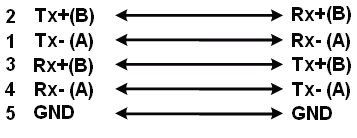 |
||||||||||||||||||||||||||||||||||||||||
|
Multidrop RS-485 2-Wire Half-duplex |
||||||||||||||||||||||||||||||||||||||||
USB-4COMi-SI-M RS-485 Device 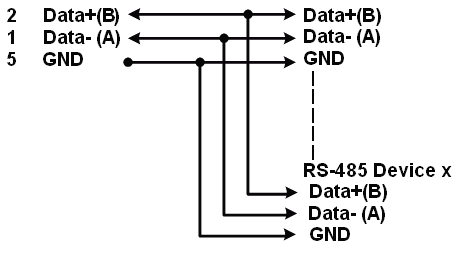 |
The 4 port USB to RS422/485 isolated serial adapter has certain accessories that work with it. These accessories are what you can order if needed.
View frequently asked product questions below. For all serial troubleshooting, visit this page.
Still need help? Reach out!
Test your components by:
When testing cables:
When testing serial ports and devices:
Note: You are required to restart your computer after disabling the Driver Signature Enforcement. Save all open work on your computer.
Disable driver signature enforcement:
When your system restarts:
When your computer restarts, Driver Signature Enforcement will be disabled and you can install the drivers.
Note: You are required to restart your computer after disabling the Driver Signature Enforcement. Save all open work on your computer.
Disable Driver Signature Enforcement:
After your computer restarts:
When your computer restarts, Driver Signature Enforcement will be disabled and you can install the drivers.
Once the driver/software is installed, follow these steps to allow the software:
Reviews
There are no reviews yet.